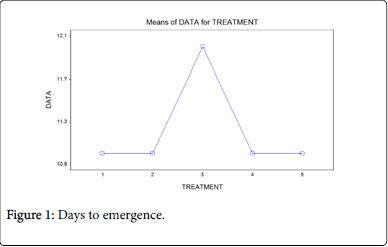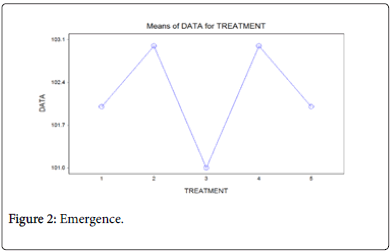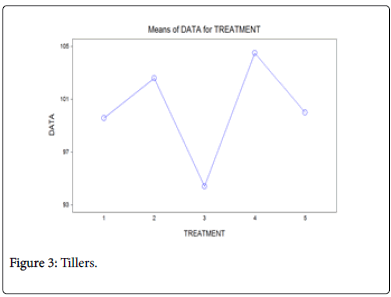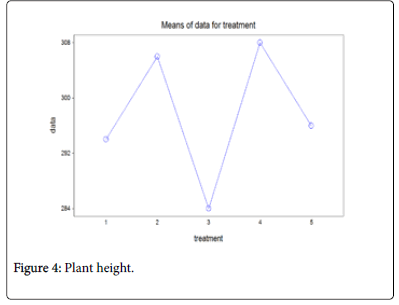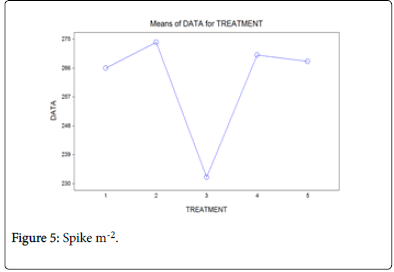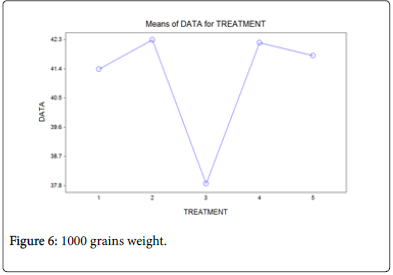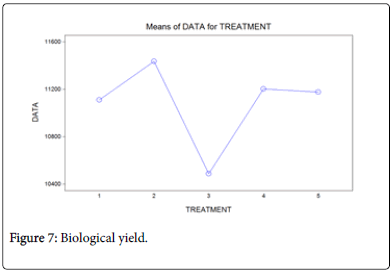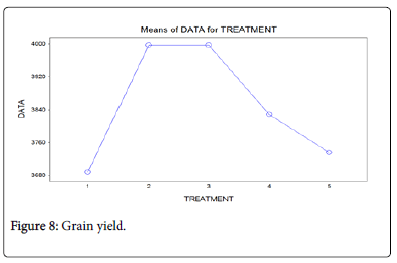Evaluating the Potential Organic Manure for Improving Wheat Yield and Quality under Agro-Climatic Conditions of Pakistan
Received: 07-Mar-2018 / Accepted Date: 22-Mar-2018 / Published Date: 28-Mar-2018 DOI: 10.4172/2329-8863.1000349
Abstract
Use of organic manures for crop productivity not only improve crop production but also improving soil physicochemical properties. It also reduces soil and water pollution by acting as chelating agent for inorganic nutrients. Keeping these things in view an experiment was carried out aiming the use of different organic manures for improving crop productivity and to select a potential organic manure that improve crop productivity compared to others. All the manures were applied at the same rate 5 tons ha-1. The results revealed that all the wheat parameters were significantly affected by differences in nature of organic manures except days to emergence. Plots receiving Poultry manures has high Spikes m-2 (274), Grains spike-1 (60), more 1000 grain weight (42.287 g), high biological yield (11435 kg ha-1) and high grain yield (3996 kg ha-1). Similarly, Sheep manure had also great effect on wheat parameters such as higher emergence m-2(103), Tillers m-2 (308), plant height (104.50 cm), Grains spike-1 (60) and similar 1000 grain weight compared to poultry manures (42.200). Cattle and Farmyard manure were also found better compared to legume residue but were found less important in improving wheat quality compared to poultry and sheep manure. Similarly, legume residues showed very poor performance in improving wheat quality compared to other organic manures. Wheat parameters were found better performed when poultry or sheep manures applied at the rate of 5 tons ha-1. Therefore, it is recommended that application of sheep or poultry manures at the rate mentioned above improve wheat components under the agro-climatic conditions of Pakistan.
Keywords: Organic manure; Poultry; Cattle; Sheep; Farmyard manures
Introduction
Wheat is an annual cereal crop and is the used as a staple food by human beings and is used for livestock feeding in all over the world. Pakistan economy is widely boost up due to the cultivation of wheat. It contributes about 3% to the total GDP of Pakistan [1]. The average production of wheat in Pakistan is much lower compared to Mexico and China. This lower production in Pakistan is due to imbalance application of fertilizers and given of lower preference to organic fertilizers [2]. Imbalance inorganic fertilizers application and no use of organic fertilizers can loosen the soil and causes increase erosion and loss of fertile soil. Therefore organic fertilizers and inorganic fertilizers proper application can improve the soil properties and increases soil fertility. Organic fertilizers/manures are the chief sources of NPK and other essential plant nutrients [3]. The most important organic sources containing N is poultry manure, farmyard manure and crop residues. Inorganic fertilizers losses from the field are more and act as the most important source of causing atmospheric pollution. Therefore, reuse of organic materials of farm can not only improve crop yield but also decreases pollution [4]. Importance of organic fertilizers cannot be ignored as they are used as substitutes of inorganic fertilizers because they improve both the physical and chemical properties of soil [5].
In all the organic fertilizers poultry manure can enhance wheat yield and quality compared to others because of containing high amount of nutrients [6]. Most of the researches of organic fertilizers showed that poultry manure improve wheat yield more efficiently like as Izunobi [7] conducted an experiment, reported that the richest source of most of the absorbable plant nutrients are contained by poultry manure. Improving yield of crops by poultry manure is because it mineralizes faster and contain high amount of basic nutrients compared to other organic fertilizers [8]. Poultry manure contains high amount of basic nutrients and therefore increases leaf area, grain yield, dry matter and chlorophyll content of plant [9]. For increases most of the crop production in different parts of the world, different organic sources such as cattle manures, poultry manures, pig manures and residues compost are recommended [10]. Residual effect of organic manures is long because the release of nutrients from organic manures are so slow due to time taken on decomposition [3].
Methodology
This research was conducted in the University of Agriculture, Peshawar at New Developmental Farm (NDF) to explore different organic manures effect on wheat yield and quality during the month of early December 2016. This experiment was carried out in randomized complete block design (RCBD) with three replications. Five treatments were used as factor. Pirsabak-2013 varieties were used as a check crop.
T1=Farmyard manure @ 5 tons ha-1, T2=Poultry manure @ 5 tons ha-1, T3=Legume residues @ 5 tons ha-1, T4=Sheep manure @ 5 tons ha-1, T5=Cattle manure @ 5 tons ha-1. No inorganic fertilizers were applied, as all the organic manures were applied at the rate of 5 tons ha-1. Effect of organic manures on the following parameters were found.
Days to emergence
Emergence data were taken by calculating days to emergence from the planting date upto 80% of seedlings appear in each plot (Figure 1).
Emergence m-2
Emergence reading were noted at the time when all plots have 50% of seedlings (Figure 2) and is converted by the following formula
Emergence m-2=(Seedling counted numbers)/(R Length × no. of rows × R-R distance (m))
Tillers m-2
Three rows of one meter long were taken from each plot (Figure 3) and the tellers were counted and were converted to m-2 by the following formula
Tillers m-2=(Counted No. of tillers)/(R-Length × No. of Rows × R-R distan (m))
Results and Discussion
Nowadays, farmers are facing lots of problems by using chemical fertilizers in terms of short term residual effect, high cost, and the disturbance in structures of soil that can cause to erosion and lead to not only affect the soil properties adversely but can also hinders the target crop yield [3]. Most of the underprivileged farmers uses both organic and inorganic manures alone and in mixed combination without knowing that which organic manure can gives us best results when used alone. Taking all of these things in view a research aiming to improve agriculture was carried out that can lead to a step towards sustainable agriculture due to its long term residual effect. Data in Tables 1 and 2 shows the effect of organic manures on the wheat yield parameters. The tables showed that organic manures effect on days to emergence is not significantly different from each other but legumes residues incorporation delayed emergence compared to others. Using organic manures improve porosity that ultimately enhance water use efficiency and thus increases biomass production [1]. It is also been reported [11] that fresh weight of wheat is enhances by application of organic manures to soil. Emergence m-2 was high by applying poultry and sheep manure and FYM and CM were not significantly different from each other.
| Treatments | Days to emergence | Emergence m-2 | Tiller m-2 | Plant height | Spikes m-2 | Grain spike-1 |
|---|---|---|---|---|---|---|
| 1 | 11a | 102AB | 294 B | 99.58C | 266C | 56B |
| 2 | 11a | 103A | 306A | 102.58B | 274A | 60A |
| 3 | 12a | 101B | 284C | 94.40D | 232D | 51C |
| 4 | 11a | 103A 308A | 308A | 104.50A | 270B | 60A |
| 5 | 11a | 102AB 296B | 296B | 104.50A | 268BC | 58AB |
Table 1: Means of the data of each parameters is listed in the table, where same letters means the results are not significant at 5% while those which are different are significant at 5% level of probability.
| Treatments | 1000 grain weight | Biological yield | Grain yield |
|---|---|---|---|
| 1 | 41.390C | 11109D | 3688D |
| 2 | 42.287A | 11435A | 3997A |
| 3 | 37.860D | 10487E | 3997A |
| 4 | 42.200AB | 11203B | 3828B |
| 5 | 41.800BC | 11175C | 3736C |
Table 2: Means of the data of each parameters is listed in the table, where same letters means the results are not significant at 5% while those which are different are significant at 5% level of probability.
Plant height (cm)
10 plants were taken randomly from each plot and there heights were recorded and then averaged (Figure 4).
Spike m-2
Randomly one row was taken from every plot and spikes were counted at four randomly different places and then averaged (Figure 5).
Thousand grains weight
Threshed seeds of each plot were collected and placed separately, thousand seeds were taken and weighed using electronic balance (Figure 6).
Biological yield (kg ha-1)
Randomly equal rows were harvested in each plot and then sundried and were weighed separately (Figure 7) and then converted into kg ha-1 by using following formula
Biological yield=(Biological yield (kg))/(R-Length × No.of Rows × R-R distance)
LR showed poor effect on seed emergence m2 and were significantly different from all others. Tillers m-2 had showed greater response to sheep manure which is not significantly different then poultry manure followed by cattle manure and farmyard, legume residues had showed lowest response so tiller m-2. Organic manures improve nutrients uptake by providing ideal conditions for both microbial activity and to uptaking nutrients from soil [12,13] manures provide ample nutrients to plants that can improve growth parameters of wheat crops [14]. Plant height shows greater response to sheep manure which is significantly different from all others. While low response of plant height were obtained by legume residue incorporation. Higher spikes m-2 were obtained by application of poultry manure which was significantly differ from other organic manures. While poor spikes m were obtained by application of legume residue to the field.
Grain yield (kg ha-1)
Each plot seeds are weighed separately and are converted into (kg ha-1) (Figure 8).
Grain yield=(Grain yield (kg))/(R-R Distance × No.of rows × RLength)
Higher grains per spike were obtained by application of poultry and sheep manures while lowest grains per spike were obtained by legume residues incorporation. Application of poultry manure also increases thousand grain weight while the lowest weight were obtained from plots with legume residue incorporation. Increased biological yield were obtained from poultry manure which was significantly different from others. While the lowest were obtained from legume residues. Poultry manure also increases grain yield while the lowest grain yield were obtained from farmyard manure. Mashori et al. [2], Memon et al. [15], Moe et al. [16] reported that soil properties and maize growth can be improved by the application of organic manures into the soil. So, Soil applied (ammended) with poultry or sheep manures can gives very precise results. It is recommended to use poultry and sheep manure for obtaining high yield.
References
- Ahmad MM, Afzal A, Ahmad AUH, Ahmad, Azeem MA (2013) Role of organic and inorganic nutrient sources in improving wheat crop production. Cercetari Agronomic in Moldova 1: 15-20.
- Mashori NM, Memon M, Memon KS, Kakar H (2013) Maize dry matter yield and P uptake as influenced by rock phosphate and single super phosphate treated with farm manure. Soil Environ 32: 130-134.
- Ahmad R, Jilani G, Arshad M, Zahir ZA, Khalid A (2007) Bio-converssion of organic wastes for their recycling in agriculture: An overview of perpectives and prospects. Anim Microb 57: 471-479.
- Alam SM, Shah SA, Ali S, Iqbal MM (2003) Effect of integrated use of industrial wastes and chemical fertilizers on phosphorus upatake and crop yields. Pak J Soil Sci 22: 81-86.
- Abbas G, Khattak JZK, Mir A, Ishaque M, Hussain H, et al. (2012) Effect of organic manures with recommended dose of NPK on the performance of wheat. J Animal Plant Sci 22: 683-687.
- Hirzel J, Rodriguez N, Zagal E (2004) Effect of different deses of NPK inorganic fertilization and organic source on maize production and soil fertility. Agric Tec Chil 64: 365-374.
- Izonubi ND (2002) Poultry Husbandry: an integrated approach for tertiary students, extension agents, policy makers and farmers. NADS Publisher Inc 192: 4-5.
- Brady C, Weils RR (1999) Nature and properties of soil twelfth Edition, Prentice Hall, New Delhi, pp: 11-74.
- Amujoyegbe BA, Opabode JT, Olayinka A (2007) Effect of organic and inorganic fertilizers on yield and chlorophyll content of maize and sorghum. African J Biotec 6: 1869-1873.
- Hidayatullah, Amanullah A, Jan, Shah Z (2013) Residual effect of organic nitrogen sources applied to rice on the subsequent wheat crop. Int J Agron Plant Prod 4: 620-631.
- Sarwar G, Naseem AR, Mujeeb F (2009) Efficacy of various organic materials for improving chemical characteristics of normal soil. Int J Agric Appl Sci 1: 97-101.
- Muneshwar S, Singh VP, Reddy KS, Singh M (2001) Effect of integrated use of fertilizer nitrogen and farm manure or green manure on transformation of N, K and S and productivity of rice-wheat system on a Vertisol. J Indian Soc Soil Sci 2001 49: 430-435.
- Nevens F, Reheul D (2003) The application of vegetable, fruit and garden waste (VFG) compost in addition to cattle slurry in a silage maize monoculture: nitrogen availability and use. Eur J Agron 19: 189-203.
- Khan P, Imtiaz M, Memon MY, Aslam M, Shah JA, et al. (2014) Response of wheat genotype NIA Sundar to varying levels of nitrogen and phosphorus. Sarhad J Agric 30: 325- 331.
- Memon M, Memon KS, Mirani S, Jamro GM (2012) Comparative evaluation of organic wastes for improving maize growth and NPK content. Afr J Biotechnol 11: 9343-9349.
- Moe K, Mg KW, Win KK, Yamakawa T (2017) Combined effect of organic manures and inorganic fertilizers on the growth and yield of hybrid rice (Palethwe-1). Am J Plant Sci 8: 1022-1042.
Citation: Mukhtiar A, Waqar A, Khalil MQ, Tariq M, Muhammad S, et al. (2018) Evaluating the Potential Organic Manure for Improving Wheat Yield and Quality under Agro-Climatic Conditions of Pakistan. Adv Crop Sci Tech 6: 349. DOI: 10.4172/2329-8863.1000349
Copyright: © 2018 Mukhtiar A, et al. This is an open-access article distributed under the terms of the Creative Commons Attribution License, which permits unrestricted use, distribution, and reproduction in any medium, provided the original author and source are credited.
Select your language of interest to view the total content in your interested language
Share This Article
Recommended Journals
Open Access Journals
Article Tools
Article Usage
- Total views: 6285
- [From(publication date): 0-2018 - Dec 02, 2025]
- Breakdown by view type
- HTML page views: 5274
- PDF downloads: 1011

